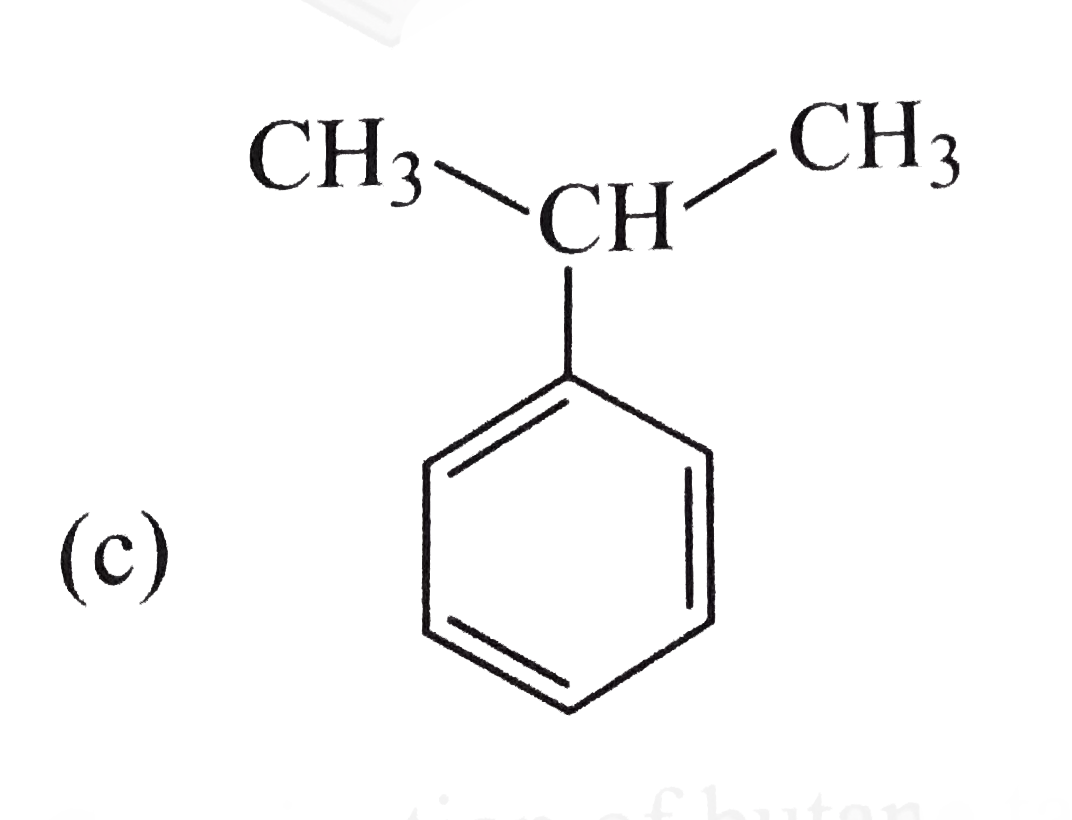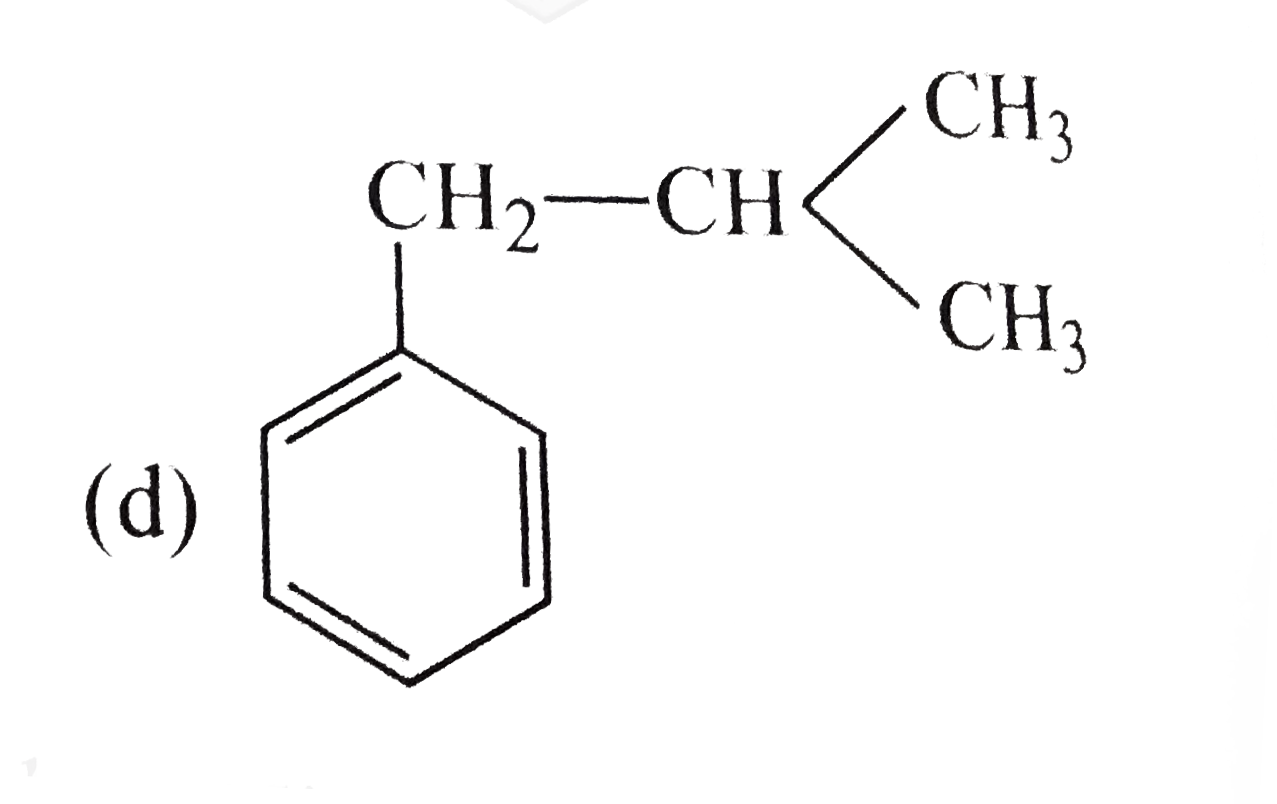Photochlorination of propane gives 48% n-propylchloride and 52% isopropyl chloride. The relative reactivity of perimary and secondary hydrognes on a per-hydrogen basis is expected to be
1:4,43
1:3.25
1:5
1:2.5
The correct Answer is:B
1∘CH32∘CH21∘CH3
Let rp and rs be the relative rates of substitution of a primary and secondary H atom, respectively. Since there are 6 primary H atoms, and statistically, each one has an equal chance of being replaced, their total rate of replacement is 6rp. Similarly, for 2 secondary H atoms, their total rate of replacement is 2rs. Since the amount of each isomers formed depends on its rate of formation,
Ratio of rates=Ratio of amounts
i.e., 6rp2rs=4852
or rprs=2×486×52=3.251
Topper's Solved these Questions
Similar Questions
Read the given passage and answer questions follow:
The hydroxyl group of an alcohol is replaced by halogen on reaction with concentrated halogen acids, phosphorus halides or thionyl chloride. Thionyl chloride is preferred because in this reaction alkyl halide is formed along with gases SO2 and HCl. The two gaseous products are escapable, hence, the reaction gives pure alkyl halides. The reactions of primary and secondary alcohols with HCl require the presence of a catalyst, ZnCl2. With tertiary alcohols, the reaction is conducted by simply shaking the alcohol with concentrated HCl at room temperature. Constant boiling with HBr (48%) is used for preparing alkyl bromide. Good yields of R- I may be obtained by heating alcohols with sodium or potassium iodide in 95%orthophosphoric acid. The order of reactivity of alcohols with a given haloacid is 3∘>2∘>1∘ . Phosphorus tribromide and triiodide are usually generated in situ (produced in the reaction mixture) by the reaction of red phosphorus with bromine and iodine respectively.
Give the reactivity order of alcohols in halogenation using a haloacid.View SolutionRead the given passage and answer questions follow:
The hydroxyl group of an alcohol is replaced by halogen on reaction with concentrated halogen acids, phosphorus halides or thionyl chloride. Thionyl chloride is preferred because in this reaction alkyl halide is formed along with gases SO2 and HCl. The two gaseous products are escapable, hence, the reaction gives pure alkyl halides. The reactions of primary and secondary alcohols with HCl require the presence of a catalyst, ZnCl2. With tertiary alcohols, the reaction is conducted by simply shaking the alcohol with concentrated HCl at room temperature. Constant boiling with HBr (48%) is used for preparing alkyl bromide. Good yields of R- I may be obtained by heating alcohols with sodium or potassium iodide in 95%orthophosphoric acid. The order of reactivity of alcohols with a given haloacid is 3∘>2∘>1∘ . Phosphorus tribromide and triiodide are usually generated in situ (produced in the reaction mixture) by the reaction of red phosphorus with bromine and iodine respectively.
Why do we prefer thionyl chloride for the preparation of alkyl halides?View Solution
Knowledge Check
- Question 1 - Select One
Statement-I: Free radical chlorination of n-butane gives 72% of 2-chlorobutane and 28% of 1-chlorobutane though it has six primary and four secondary hydrogens.
Because Statement-II: A secondary hydrogen is abstracted more easily than the primary hydrogen.AStatement-I is True, Statement-II is True, Statement-II is a correct explanation for Statement-IBStatement-I is True, Statement-II is True, Statement-II is NOT a correct explanation for Statement-ICStatement-I is True, Statement-II is False.DStatement-I is False, Statement-II is True. - Question 2 - Select One
Free radical halogenation takes place in the presence of light or at high temperature (abov 773K.) Formation of halogen free radical intermediate takes place in first step called chain initiation step.
CI2hv−−→2CI
This reaction is mainly given by those compound which have atleast one hydrogen atom present at sp3−hybrid carbon.
Reactivity of sp3−hybrid carbon depends on the reactivity of reaction intermediate.
The relative rate of formation of alkyl radicals by a chlorine radical is :
Tertiary(5)>Secondary(3.8)>Primary(1)
Percentage yield of the prodcut =Relative amount×100Sum of relative amounts
Relative amount = Number of hydrogen atoms on the respective carbon × relative reactivity.
NBS (N-bromo succinimide) is used for bromination at allylic and benzylic carbon, whereas Br2/hv gives bromination at benzylic allylic and alkyl carbon.
CH3CH2CH2CH3+CI2hv−−−−−→Light
CH3O∣CHCH2CH32-Chlorobutane+CH3CH2CH2CI1-Chlorobutane
Percentage yield of 2-chlorobutane will be:A1521×100B2121×100C621×100D321×100 - Question 3 - Select One
Free radical halogenation takes place in the presence of light or at high temperature (abov 773K.) Formation of halogen free radical intermediate takes place in first step called chain initiation step.
CI2hv−−→2CI
This reaction is mainly given by those compound which have atleast one hydrogen atom present at sp3−hybrid carbon.
Reactivity of sp3−hybrid carbon depends on the reactivity of reaction intermediate.
The relative rate of formation of alkyl radicals by a chlorine radical is :
Tertiary(5)>Secondary(3.8)>Primary(1)
Percentage yield of the prodcut =Relative amount×100Sum of relative amounts
Relative amount = Number of hydrogen atoms on the respective carbon × relative reactivity.
NBS (N-bromo succinimide) is used for bromination at allylic and benzylic carbon, whereas Br2/hv gives bromination at benzylic allylic and alkyl carbon.
Select most reactive compound for chlorination in presence of light :A B
B C
C D
D
Read the given passage and answer questions follow:
The hydroxyl group of an alcohol is replaced by halogen on reaction with concentrated halogen acids, phosphorus halides or thionyl chloride. Thionyl chloride is preferred because in this reaction alkyl halide is formed along with gases SO2 and HCl. The two gaseous products are escapable, hence, the reaction gives pure alkyl halides. The reactions of primary and secondary alcohols with HCl require the presence of a catalyst, ZnCl2. With tertiary alcohols, the reaction is conducted by simply shaking the alcohol with concentrated HCl at room temperature. Constant boiling with HBr (48%) is used for preparing alkyl bromide. Good yields of R- I may be obtained by heating alcohols with sodium or potassium iodide in 95%orthophosphoric acid. The order of reactivity of alcohols with a given haloacid is 3∘>2∘>1∘ . Phosphorus tribromide and triiodide are usually generated in situ (produced in the reaction mixture) by the reaction of red phosphorus with bromine and iodine respectively.
How are PBr3 and PI3 prepared for halogenating the hydroxyl group of alcohols ?View SolutionRead the given passage and answer questions follow:
The hydroxyl group of an alcohol is replaced by halogen on reaction with concentrated halogen acids, phosphorus halides or thionyl chloride. Thionyl chloride is preferred because in this reaction alkyl halide is formed along with gases SO2 and HCl. The two gaseous products are escapable, hence, the reaction gives pure alkyl halides. The reactions of primary and secondary alcohols with HCl require the presence of a catalyst, ZnCl2. With tertiary alcohols, the reaction is conducted by simply shaking the alcohol with concentrated HCl at room temperature. Constant boiling with HBr (48%) is used for preparing alkyl bromide. Good yields of R- I may be obtained by heating alcohols with sodium or potassium iodide in 95%orthophosphoric acid. The order of reactivity of alcohols with a given haloacid is 3∘>2∘>1∘ . Phosphorus tribromide and triiodide are usually generated in situ (produced in the reaction mixture) by the reaction of red phosphorus with bromine and iodine respectively.
Name the reagents that can be used for halogenation of alcohols.View SolutionRead the given passage and answer questions follow:
The hydroxyl group of an alcohol is replaced by halogen on reaction with concentrated halogen acids, phosphorus halides or thionyl chloride. Thionyl chloride is preferred because in this reaction alkyl halide is formed along with gases SO2 and HCl. The two gaseous products are escapable, hence, the reaction gives pure alkyl halides. The reactions of primary and secondary alcohols with HCl require the presence of a catalyst, ZnCl2. With tertiary alcohols, the reaction is conducted by simply shaking the alcohol with concentrated HCl at room temperature. Constant boiling with HBr (48%) is used for preparing alkyl bromide. Good yields of R- I may be obtained by heating alcohols with sodium or potassium iodide in 95%orthophosphoric acid. The order of reactivity of alcohols with a given haloacid is 3∘>2∘>1∘ . Phosphorus tribromide and triiodide are usually generated in situ (produced in the reaction mixture) by the reaction of red phosphorus with bromine and iodine respectively.
Which catalyst is required when we prepare halogen compounds using concentrated HCI?View SolutionState whether each of the following is true or false.
a. Photobromination of 2-methylpropane gives a mixture of 1-bromo-2-methylpropane gives a mixture of 1-bromo-2-methylpropane and 2-bromo-2-methylpropa ne in the ratio 9:1
b. The percentage of n-propyl chloride obtained in the chlorination of propane is about 56%.
c. The percentage of 1-chloro-2-methylpropane obtained in the chlorination of isobutane is about 64%.
d. The percentage of n-propyl bromide in the bromination of propane is 44% . The relative reactives of 3∘ , 2∘ and 1∘ H atoms are 1600:82:1 .View SolutionFree redical halogenation takes place in presence of light or at high temperature (above 500∘C). Formation of halogen free radical intermediate takes place in first step called chain initiation step.
Cl2hv−−→2Cl∗
This reaction is mainly given by those compounds which have at least one hydrogen atom present at sp3 -hybrid carbon. Reactivity of sp3-hybrid carbon depends on the reactivity of reaction intermediate.
The relative rate of formation of alkyl radicals by a chlorine radical is:
Tertiary(5)>Secondary(3.8)>Primary(1)
Percentage yield of the product=Relative amount×100Sum of relative amounts
Relative amount=Number of hydrogen atoms on the respective carbon×relative reactivity.
NBS(N-bromosuccinimide) is used for bromination at allylic and benzylic carbon, whereas Br2/hv gives bromination at benzylic, allylic and allyl carbons.
Select most reactive compound for chlorination in presence of light:View Solution
